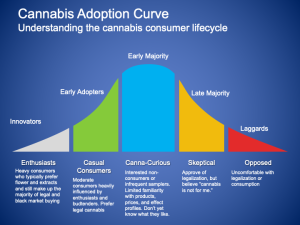Cannabis
กัญชา (ชื่อวิทยาศาสตร์: Cannabis, sp.) เป็นพืชล้มลุกชนิดหนึ่งในวงศ์ Cannabidaceae ใบมนแฉกลึกเข้าไปทางก้านหลายแฉก ดอกสีเขียว ช่อดอกเพศผู้และช่อดอกเพศเมียอยู่ต่างต้นกัน มีการเก็บเกี่ยวกัญชาด้วยจุดประสงค์หลายประการ เช่น เส้นใยบนใบสามารถนำไปทำเป็นเสื้อได้ ใบและช่อดอกเพศเมียที่แห้งใช้สูบมีสรรพคุณช่วยแก้โรคเบาหวาน ความดัน มะเร็ง กัญชาผลิตเตตร้าไฮโดรแคนนาบินอล (THC) จำนวนมาก สาร THC จำนวนมากทำให้เกิดอาการเคลิ้ม ซึ่งทำให้เป็นพืชยอดนิยมที่ใช้ทั้งในด้านนันทนาการ การแพทย์ทางเลือก และยาวิจัยทางคลินิก
โดยปัจจุบัน กัญชาได้ถูกกฎหมายในประเทศไทยตั้งแต่เดือนเมษายนของปี 2022
| ⚠️ Drug Usage Disclaimer: | The information provided in this text is for educational and informational purposes only. The author does not condone the use of psychoactive substances or encourage individuals to engage in any illegal activities, which may have serious physical, emotional, and legal consequences. The author cannot be held responsible for any illegal activities that readers may engage in based on the information presented in this text. The concept of spiritual experiences from psychoactive substance use is a controversial and subjective topic, and the author encourages readers to use discretion and make informed decisions regarding their own practices while seeking professional advice if necessary. |
|---|
สถานที่จำหน่ายกัญชาถูกต้องตามกฎหมายของประเทศไทย
Cannabis Smoker Classes
- เด็กดมบุ๋ย
- เด็กวิ่งของ
- เด็กข้างเขียง
- คนยำ (พ่อครัว)
Technical Description
Cannabis Sativa: The UN-Sanctioned Forbidden Fruit of Innovation
A Scientific-Satire Investigation Into The World’s Most Confusingly Controlled Plant
In the grand geopolitical theater of controlled substances, few entities have endured a more schizophrenic existence than Cannabis sativa, a botanical specimen that has spent the last century oscillating between “global threat” and “miracle crop.”
Despite its well-documented medicinal, industrial, and recreational applications, Cannabis sativa remains both a UN-sanctioned controlled substance and a legally recognized agricultural commodity—depending on where you stand (or more precisely, which country you are in).
This contradiction has led to one of the most bizarre regulatory sagas in human history, where a plant that could decarbonize construction, replace plastics, and provide medicinal relief is still treated as an international contraband commodity.
Let us embark on a semi-scientific exploration of the irony, hypocrisy, and sheer bureaucratic absurdity surrounding this misunderstood flora.
Section I: The UN War on The Green Menace
The United Nations, in its infinite wisdom, classifies Cannabis sativa under the Single Convention on Narcotic Drugs (1961), where it is lumped together with substances of high addiction potential, such as heroin and cocaine.
This means that, according to global treaties, the international trade of cannabis or its derivatives is still officially prohibited, regardless of whether a country has legalized it domestically.
Yet, in a spectacular display of regulatory hypocrisy, individual nations—and even U.S. states, including Washington D.C. (home of federal lawmakers, mind you)—have gradually decriminalized, legalized, and even industrialized the very same substance that international law still condemns.
This has resulted in a legal paradox wherein:
- A U.S. citizen in Colorado can legally purchase cannabis for recreational use, but if they attempt to transport it across state lines, they are now a drug trafficker.
- Canada has fully legalized cannabis nationwide, but cannot export it internationally because of global trade restrictions.
- The Netherlands, famous for its cannabis culture, technically does not even have legal cannabis, but rather a “tolerated” gray market system.
Thus, we exist in a global Twilight Zone, where cannabis is:
- Too dangerous to trade internationally
- Too useful to prohibit domestically
- Too profitable for governments to ignore
Section II: The Industrial Irony—Hempcrete, Bioplastics, and Other Banned Innovations
While the United Nations continues to enforce trade restrictions on cannabis, the plant itself has already begun solving 21st-century problems.
Take hempcrete, for example—a carbon-negative building material derived from Cannabis sativa. This lightweight, fire-resistant, and mold-proof alternative to concrete has the potential to revolutionize sustainable architecture.
The only problem? Its global trade is restricted.
Similarly, hemp-derived bioplastics, textiles, and even biofuels could provide eco-friendly alternatives to petroleum-based products.
But alas, thanks to the vestigial limbs of 20th-century drug policy, international restrictions still hinder research, funding, and production.
Thus, we have entered a new era of regulatory absurdity, where:
- The world is desperately searching for sustainable materials, but refuses to legalize one that already exists.
- Governments subsidize fossil fuel industries, while banning an alternative crop that can replace them.
- Pharmaceutical companies spend billions on synthetic drugs, while a plant with medicinal properties is still classified as a narcotic.
The irony is so potent, it could probably get you high.
Section III: The Future—A Green Industrial Revolution on Hold
If the UN’s regulatory grip were to relax, we might witness a technological revolution driven by one of the most versatile plants known to man.
Imagine a world where:
- Cities are built with hempcrete skyscrapers that absorb CO₂ instead of emitting it.
- Biodegradable plastics derived from hemp replace the trillion-dollar petrochemical industry.
- Farmers cultivate cannabis as a staple crop, not an underground economy.
Yet, until global trade laws are revised, these innovations remain trapped in bureaucratic purgatory, while corporations continue extracting resources from an increasingly exhausted planet.
In the meantime, Cannabis sativa remains an international Schrödinger’s Plant—simultaneously legal and illegal, accepted and condemned, farmed and feared.
And thus, we end with one final question:
When will the world finally let the plant do its job?
